
by Dharam CW2 | Apr 30, 2024 | Project Management
Stakeholder Relationships
In project management, having strong relationships with stakeholders is critical to success. As someone who has mentored thousands of PMP, PgMP, and PfMP professionals, I have seen firsthand how strategic stakeholder engagement can transform project outcomes.
Ways to approach Stakeholder Relationships
Below are some essential strategies for building and maintaining these crucial relationships:
1. Map the territory: Understand the stakeholder hierarchy and create detailed profiles for individual and group stakeholders.
2. Design relationship pathways: Use relationship maps to illuminate interactions, thereby ensuring timely and effective communication.
3. Consistency and integrity: Always interact with professionalism and authenticity, building trust through reliability and ethical behavior.
4. Meet and exceed expectations: Foster trust and bolster confidence by managing and surpassing stakeholder expectations, committing to your promises, and maintaining transparency.
5. Support to succeed: Focus on how you can support stakeholders in ways that benefit project goals, enhancing mutual success.
Let’s share our ideas on personalizing our approach to stakeholder management and take our projects to new heights of success.
🚀 Elevate Your Project Management Career:
– Register for my upcoming PgMP/PfMP Success Story Webinar: https://bit.ly/3TSx8fj
– Book an obligation-free consultation session on Project management Career, training, and certifications: http://talktodharam.com
– Discover training offers and certification discounts: https://bit.ly/3jWVepD
– Stay updated with our Q&A series and certification success stories by subscribing to the vCare Project Management YouTube channel at https://bit.ly/2YF0wJl
– Follow my podcasts and interviews with Project Management Experts on YouTube at https://bit.ly/2NDY8wd
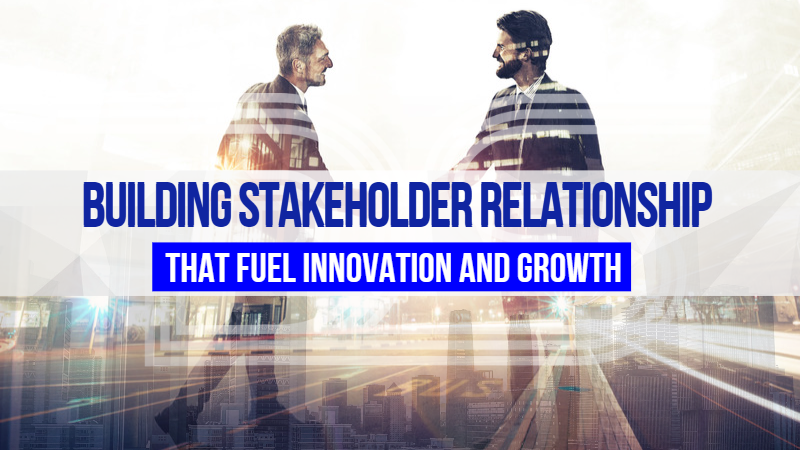
by Dharam CW2 | Aug 25, 2023 | General
The modern workplace is undergoing a significant transformation. As a result, project professionals in both the public and private sectors worldwide have started to recognize the full range of benefits that successful project management can bring to their businesses and are prepared to make the required adjustments, particularly on cultural changes.
The success of each project is dependent on an effective project management strategy. Considering the next generation of project professionals, it is critical to have an efficient leader who can direct this process since it is methodically planning, organizing, and executing a pre-determined series of procedures to maximize resource utilization and achieve objectives. Project goals will likely be met with a manager monitoring adequate planning and checking off milestones.
To compete in the upcoming competitive market, a project manager must have the technical, digital, and other essential project management skills to comprehend future project challenges. On the other hand, a project leader with an effective skill set can tackle all the challenges in a project in the right way. So here are some of the challenges and skill sets to manage a project for the next generation of project managers.
Challenges of Project Management
According to data provided in the PMI’s Pulse of the Profession 2020, 11.4 percent of corporate investment is lost owing to poor project performance.
What variables might contribute to poor project performance? There are examples of a need for more precise planning, inconsistent procedures and techniques, incorrectly managing or accounting for all project stakeholders, budget overruns, and other causes.

Categories of Project Failure
However, if we take a step further, the causes of project failure fall into three major categories:
- People
- Processes
- Communication
Let’s look at the most common challenges for project managers and some tips on how to overcome them.

Challenges of Project Management
- Undefined Goals
Identifying project goals is one of the most common challenges in project management. The entire project and team might suffer when objectives need to be clearly defined. When top management cannot agree on or support undefined goals, the project has a limited likelihood of success. To define and convey clear goals, the project manager must ask the right questions and make the right decisions.
- Scope Creep
“Scope creep” occurs when incorrect project management permits the scope of a project to expand beyond its initial objectives. Clients and supervisors may request modifications to a project, requiring the project manager to examine each request and determine how and whether to accept it meanwhile also conveying the implications to all stakeholders regarding budget and timelines.
- Inadequate Skills for the Project
A project may necessitate the use of talents that the project’s contributors may need to have. Project management may assist a project manager in determining the required competencies, assessing existing personnel, and recommending training, outsourcing, or recruiting extra people.
- Lack of Accountability
When each team member accepts responsibility for their role in project success, the project manager’s leadership characteristics may come through. A lack of responsibility, on the other hand, might bring a project to an end. Learning to lead groups toward a shared objective is an essential part of project management.
- Improper Risk Management
Another key aspect of project management is learning to cope with and plan for risk. Because projects rarely go as planned, risk management is a desired project manager trait. To do their work effectively, project managers must solicit input, build trust, and understand which aspects of a project are most likely to deviate from the original plan.
- Ambiguous Contingency Plans
Project managers must understand which path to pursue in pre-defined “what-if” situations. The entire project may become entangled in unexpected problems if contingencies are not recognized. On the other hand, requesting that people identify possible problem areas can result in a smooth and successful project.
- Poor Communication
Poor communication can cause major project management issues. Project managers must offer direction at all project stages so that each team member understands what is expected from them. Therefore, effective communication with all people involved in the project is critical to its success.
- Resource Deprivation
Management must offer adequate resources for a project to function smoothly and successfully. The project management process aids project managers in establishing demands and securing approval up front, as well as how to assign and prioritize resources during a project.
- Lack of Stakeholder Engagement
A project can be ruined by an uninterested team member, customer, CEO, or vendor. A skilled project manager communicates openly and invites input at every stage to increase participant participation.
- Digital Transformation
Adapting to the correct tools, systems, and procedures becomes even more crucial as more firms board the digital transformation train. This difficulty stems from adapting to the appropriate project management system, enabling teams to construct, change, and improve existing procedures to expand and scale.
Overall, project management is in great demand and isn’t going away anytime soon. Indeed, project management is anticipated to expand by 33% by 2027. However, to keep up with the ever-changing business landscape, project managers must be updated on proper project management methods and trends.
Major Challenges for the Next Generation Project Managers

Major Challenges for the Next Generation Project Managers
- The first major challenge project managers must confront is technology globalization and the disruption of traditional corporate culture and model. This aspect includes eliminating the requirement to do business or manage projects from a single place. The adaptation of the “virtual team” has become a must, and a company’s agility might mean the difference between success and failure. What used to take months may now be accomplished instantly, emphasizing the necessity of a company’s ability to fast and naturally adapt to the fluctuating nature of today’s technology culture.
- The second major concern is worker involvement, a project manager’s capacity to grasp various roles and responsibilities and use agility to wear numerous “hats” depending on the project. Knowing generational drives, establishing moral leadership, and understanding how the team performs are all part of this.
- Finally, project managers will be impacted by innovation and risk. The problem is figuring out how to strike a balance between innovation and risk—as managing risk is an important project management skill—but without it, it’s hard to realize the entire project’s potential.
Future Trends of Project Management
Consider project management ten years ago: fewer tools, smaller teams, and more straightforward tasks. Since then, the project landscape has changed dramatically, with important developments such as:
- Blockchain
- Artificial intelligence
- Sustainability
- Remote teams

Future Trends of Project Management
Trend 1 – Blockchain
More businesses use blockchain technologies for management, such as when conducting dispute investigations. The capacity of blockchain to automatically update data makes it ideal for reconciling records and transactions. One of the most significant contributions of blockchain to project management will be smart contracts, which are effectively self-executing contracts powered by computer code.
Smart contracts reduce the number of key functions within the project manager’s scope, such as checking on project milestones and assigning new ones, which speeds up management processes. As a result, quicker workflow assures project completion on time and improves a company’s overall performance.
Trend 2 – Artificial Intelligence
Artificial intelligence is increasingly finding its way into project management systems, managing anything from predictive analysis to risk management. Because of its efficacy, as per the PwC report, by 2030, AI is expected to contribute:
- $42.7 B (7.7%) to Egypt’s economy
- $135.2 B (12.4%) to Saudi Arabia’s economy
- $96.3 B (13.6%) to the UAE economy
The primary capacity of AI is to provide data insights for decision-making, which increases the agility of any given project.
Trend 3 – Sustainability
Project sustainability is more critical than ever now. Governments and societies worldwide are demanding greener alternatives throughout the life cycle of a project.
Green initiatives are cost-cutting solutions for businesses. For example, energy is required for project completion, and shifting to renewable sources reduces costs. In addition, this frees up resources that may be directed toward other essential areas like innovation and research. Meanwhile, sustainable practices improve a company’s reputation and encourage consumer loyalty.
Trend 4 – Remote Teams
Remote teams have been the norm since the advent of communication technology. As a result, businesses gain from a more diverse and borderless talent pool easily available through contracts. In addition, they spend less on office space, travel, and other administrative expenses.
Data from Upwork’s Future Workforce Report 2021 revealed that more than half of the US population was working remotely to some level. Furthermore, 40.7 million Americans will likely be fully remote during the next five years.
Furthermore, in its 2022 State of Remote Work Report, Buffer discovered that 97% would promote remote work to others and continue to work remotely, at least for some time or for the rest of their lives. On the other hand, just 26% of businesses are prepared to offer a remote work environment.
As a result, it’s not unexpected that more workers anticipate that workplaces will become entirely virtual over the next several years. In general, remote working arrangements enable businesses to extend their resources while increasing operational efficiency. As such, they are crucial in developing lean, competitive firms.
Key Skills needed for Next-Generation Project Managers
Because of rising trends such as remote teams, digitalization, and automation, project management has changed dramatically in recent years. More companies rely significantly on technology to plan, execute, and monitor work.
As an example:
- Big data and artificial intelligence for better risk forecasting
- Remote progress tracking using digitization technologies
- Automation software for more efficient execution
These solutions have improved firms’ management capabilities and altered project management’s future.
According to Gartner research, 80% of management duties will be automated by 2030, and future managers will need more technical skills. They must be knowledgeable about cybersecurity, blockchains, machine learning, and robots, all of which are expected to play larger roles in management.
To stay up with trends in modern project management, a fundamental understanding of topics such as data science, conflict resolution, and entrepreneurship is required. For example, data science skills may assist a manager in incorporating AI into more elements of the project life cycle. Here’s a closer look at what these skills include and how they’ll stay up with future innovations in project management.

Key Skills Needed For Next Generation Project Managers
Skill 1 – Data Science
Big data insights are essential management tools in the future, especially for large projects with extensive life cycles. In terms of planning, insights from previous projects indicate inefficiencies that can guide the current project, such as the number of idle hours and their causes. In terms of execution, data analytics assess progress and spot deviations early, such as changes in material prices and exchange rates that exceed estimates.
Skill 2 – Conflict Resolution
Today’s projects are extremely complicated, with constantly changing deliverables. As a result, conflicts are never far away.
These conflicts, if left unaddressed, can undermine your team’s performance, resulting in delays and missed deliverables. Managers must thus understand the aspects of conflict resolution, such as:
- Behavioral and organizational aspects of a positive workplace
- Effective communication
- Effective contingency planning
Skill 3 – Entrepreneurship
Project managers are essentially CEOs. On the one hand, they are in charge of project deliverables, while on the other, they are negotiating with shareholders and setting targets based on estimates. As a result, being productive requires more than technical and administrative skills. Project managers must also have entrepreneurship skills, such as strategic thinking and market insight. This skill is beneficial for modifying deliverables, which is typical in agile projects like software development.
Skill 4 – Resource Management
Budgets and timeframes became tighter as projects got more significant and more complicated. Today’s project managers must balance budget constraints, deliver quality, and achieve deadlines with limited resources. They are entrusted with creating a lean organization.
For optimal efficacy, a delicate balance of resource allocation is required, as over-allocation to one activity inhibits the others. So, managers must understand resource management principles such as equilibrium shifts and flexibility.
Skill 5 – Digital Skill
Digital skills are essential for future project managers. According to the CBI’s report on developing a world-leading innovation economy, upskilling employees with digital skills is critical. However, the digital skills pipeline could be improved. They believe more should be done to foster more ambition in that field.

Digital Skills For Project Managers
Project managers need to have the following digital skills:
- Data analysis, analytics, and management
- Data security and protection
- Compliance with the rules and regulations
- Leadership and collaboration online
- Management of knowledge
- Decision-making based on data.
Considering the vital significance of the project manager’s role and how it changes, here is a list of additional skills for project leaders to follow in the present and future to enhance their careers and succeed.

Skills For Future Project Leaders
- Emotional Intelligence: The capacity to detect and interpret events and interactions (both verbal and nonverbal) in the context of the project plan.
- Adaptive Communication:The ability to explain one’s views to various individuals, groups, and cultures, whether orally or in writing, utilizing the most successful communication approaches for each group.
- People Skills: The ability to rapidly establish and maintain strong connections with team members and stakeholders.
- Management skills: The capacity to serve, encourage and concentrate a team, and create team member collaboration.
- Flexibility:The willingness and capacity to modify one’s project management style and course of action in response to business needs.
- Business Skills:Understanding the organization’s business, strategy, and industry. Understanding of a plan and ability to coordinate tactical work around that strategy.
- Analytical abilities:The capacity to think through circumstances and make judgments.
- Customer Focus:The ability to comprehend the end user’s or end customer’s demands and the drive to guarantee that projects meet those needs.
- Results-Orientation:The capacity to do tasks efficiently and successfully.
- Character:The project manager should have a pleasant demeanor and a solid moral and ethical foundation.
Final Thoughts
With a focus on the future generation, we’ve entered a project management world where we need to be aware of the key challenges we’ll encounter as project managers and the skills we’ll need to improve to succeed: technology globalization, worker engagement, and the battle between innovation and risk. There are, however, a few crucial insights to remember as you continue your journey through the strange and ever-changing world of project management.
- Be agile or be gone:Business constantly needs greater flexibility, strategy, and adaptability than ever before. No one strategy will work every time; knowing how to adjust to change with agility and rapidity is essential.
- Expect all teams to act differently:Teams will always be more diverse than those who make them up. However, you can lead more successfully if you genuinely grasp your team and each member’s unique imperatives. Because project teams determine project success, one of the most crucial skills of a competent project manager is the ability to construct an effective, high-performing team.
- Help team members understand the big picture:This will assist them in preparing for obstacles. When attempting to resolve an issue or manage change, keep the immediate consequences in mind to prevent losing sight of the forest for the trees.
Feel free to check out my discussion on this topic with Thomas Walenta in YouTube

by Dharam CW2 | Jul 24, 2023 | General
Delivering a successful project is challenging, especially when there are multiple stakeholders. However, even if a project is performed on time, on budget, and to the expected scope, it can still be regarded as a success only if the stakeholder expectations are managed appropriately.
Each project stakeholder has certain expectations. Project managers are at the forefront of potentially disastrous situations when such expectations conflict. They must address and resolve the issue or risk jeopardizing the project and their position. Because the fundamental cause of problems is only sometimes apparent, project leaders and teams must analyze links between issues and stakeholder motives using interpersonal skills such as resolving conflict, resistance to change, and trust building.

Project Stakeholders
Project Stakeholders
A stakeholder is an individual, group, or organization that is affected by the result of a business venture or project.
Stakeholder interactions may positively or negatively impact the project’s life cycle. Thus, a project leader must identify important stakeholders and develop a stakeholder management plan to satisfy their demands. Using project management tools and strategies to keep track of the key stakeholders is an excellent method to remain on top of things and ensure that project stakeholders remain satisfied and productive.

Types of Stakeholders
Internal Stakeholders
An internal stakeholder is somebody whose interest in the project is directly linked to their affiliation with the entity in charge. Internal stakeholders want the strategic and commercial goals of the project to be realized. They might be project managers, team members, sponsors, owners, or investors.
External Stakeholders
External stakeholders are not directly linked with the company but are important to the business or are influenced by the project in some way. Those are frequently supply chain participants, creditors, or public groups.
Stakeholder Management
The stakeholder management process includes communicating project status, expenses, and barriers to stakeholders to increase visibility, navigate changes in project direction, and manage expectations. Project stakeholders are those involved in the project or whose interests may be influenced by the project’s execution or completion.
Stakeholder management helps project managers keep change at the forefront of their thoughts while making it less intimidating. Furthermore, the stakeholder management plan is a reminder for every interaction the project managers have with direct or indirect stakeholders, helping them maintain a genuine link between the project and day-to-day operations.
Closing the Stakeholder Expectation Gap – Means
An effective stakeholder management process ensures that timely and relevant feedback is provided, and that the stakeholder management strategy directs the change effort. The project manager maintains stakeholder expectations, resolves conflicts, and identifies and fixes any problems that develop throughout the project. In general, the following are the fundamental parts form the stakeholder management process:

The Necessary Elements For Successful Stakeholder Management
- Managing stakeholder expectations: The project is more likely to succeed when stakeholders’ expectations are actively managed. As a result, to ensure perfect conformance with project goals and expectations and to continue the project management effort, the project manager must continually negotiate and influence the demands of stakeholders.
- Managing stakeholder perception: It is critical for project success to ensure that stakeholders are involved in the project regularly and are kept up to date on the project’s progress. High-level stakeholder perception increases the likelihood that stakeholders will provide the necessary support and the project will be completed as intended.
- Keeping track of stakeholder activity: The project manager is primarily responsible for recording and tracking all stakeholders’ activity. As a result, to secure stakeholder acceptance and project communications plan adherence, the project manager should formally document all contacts with stakeholders and keep records of the project’s outcomes.
- Solving problems and resolving conflicts: To avoid challenges and conflicts, the project manager should address stakeholders’ concerns and identify risks and threats in collaboration with conflict management. By referring to change requests, the project manager can generate solutions.
Understanding the components of the managing stakeholder’s process enables the project manager to engage with stakeholder expectations and demands and build action plans to be used when disputes and challenges emerge. The project manager can utilize the following tools to assess conflicts and challenges, as well as manage stakeholders on an individual and group level:

Tools To Assess Conflicts And Challenges In Managing Stakeholder’s Process
- Issue logs: An issue log is a tool for assessing issues and documenting resolutions. It is a document with a rigid categories structure that allows each issue to be placed in the appropriate category (issue group). The project manager uses problem logs to ensure that each stakeholder understands the project and maintains positive working interactions among all stakeholders, including project team members.
- Change Logs: It is a tool for documenting any changes that occur throughout a project. The project manager uses change logs to track changes and their impact on project goals and deliverables. A change log should be provided to project stakeholders and should include data on changes to risks, uncertainties, costs, and budgets.
A change request for project deliverables may result from the technique for managing and engaging stakeholders. Changes to the stakeholder management approach and registry are also feasible. The method of managing stakeholders allows for evaluating and modifying stakeholder benefits created earlier in the project’s life cycle.
Five pitfalls to address while dealing with the expectations of stakeholders

5 Pitfalls To Address While Dealing With The Expectations Of Stakeholders
- Identify the stakeholders
A project often involves many stakeholders, and it can take time to identify all of them. A stakeholder is a person, a group, an organization, or a set of organizations that are actively involved in or may be affected by the project. Stakeholders can have an impact on a project in a variety of ways.
For example, if a stakeholder is top management in an organization and is not completely committed to a project, it may drastically limit buy-in throughout the business. Founders and C-suites are also stakeholders who can positively or negatively impact a project. Therefore, the identification of stakeholders is a critical step in managing expectations.
- Classifying stakeholders
Effective stakeholder management necessitates a project manager categorizing stakeholders based on their role in project completion. A project manager must determine which stakeholders are supporters and which may be obstacles to the project. It might be challenging to define the types of risks, where and when each risk exists, the impact on the project, or how to build strategies to handle possible risks if stakeholders cannot be classified.
- Mapping expectations
Project managers must resolve possible concerns, keep stakeholders involved and motivated, and finish the project on time. A project manager must have a good understanding of all stakeholders’ expectations. Stakeholder analysis and adequate documentation can be useful in mapping expectations. Stakeholders may have different priorities when completing tasks, milestones, or the full project. Their interests may be interpreted differently and have different definitions of success.
For example, one stakeholder may prioritize project completion on time, while another defines success as keeping it under budget. Mapping expectations and obtaining clarity among all stakeholders enhances the possibility that a project manager and their team can effectively complete a project.
- Using appropriate communication methods
Stakeholder management requires determining and implementing appropriate communication methods. To successfully manage stakeholder expectations, a project manager must establish the available and preferred communication mechanisms for stakeholders. A poor or incorrect communication approach can lead to distrust and dissatisfaction between stakeholders and a project manager. It is also essential to adjust communication tactics and frequency based on elements such as time, message, purpose, secrecy, or changes based on stakeholder contexts.
- Engaging stakeholders
Stakeholder engagement during the project with frequent updates boosts stakeholder confidence, which is essential for project success. In addition, efficient stakeholder management necessitates the involvement of stakeholders in decision-making by the project manager.
Although a project manager may believe they have already determined the optimal course of action, they should incorporate stakeholders in procedures and pertinent talks to ensure all options have been examined; otherwise, key possibilities and expectations may be missed.
Closing the Stakeholder Expectation Gap – Methods
Before beginning a new project, start by identifying all stakeholders. First, identify those impacted by the project and the organizations that will influence the project. Then, using the strategy outlined below, begin developing strong relationships with each stakeholder.

Closing the Stakeholder Expectation Gap – Methods
- Analyze stakeholders
Conduct a stakeholder analysis or an evaluation of the key participants in a project and how the initiative will affect their issues and requirements. Determine their unique qualities and interests. Find out what motivates them and what frustrates them. Define responsibilities and levels of engagement, and assess whether there are any disputes among stakeholders.
- Assess the influence
Determine the extent to which stakeholders can have an impact on the project. The more powerful a stakeholder is, the more a project manager will require assistance. When evaluating stakeholders, consider the question, “What’s in it for them?” Knowing what each stakeholder needs or desires from the project allows the project manager to measure their degree of support. Remember to weigh support against influence, like Is it more necessary to have strong support from a low-level stakeholder or moderate support from a high-level stakeholder?
- Understand their expectations
Determine the exact expectations of stakeholders. Then, when necessary, seek clarification to ensure they are thoroughly understood.
- Define “success”
Every stakeholder may have a distinct definition of project success. Discovering this towards the end of the project is a potential disaster. Instead, gather definitions and integrate them into the objectives to guarantee that all stakeholders support the final results.
- Keep stakeholders involved
- Don’t just provide updates to stakeholders.
- Solicit their opinions.
- Schedule time for brief meetings to get to know them better.
- Determine each stakeholder’s ability to engage while keeping time restrictions in mind.
- Keep stakeholders informed
- Send regular status updates.
- One update each week is generally adequate.
- Hold project meetings as appropriate, but allow enough time between them.
- Respond to stakeholders’ inquiries and emails as soon as possible.
- Regular contact is usually valued – and may help ease the impact when you have unpleasant news to deliver.
These are some of the fundamentals of developing effective stakeholder connections. However, like with any relationship, there are subtleties that every effective project manager knows, such as understanding the distinctions and responding successfully to various types of stakeholders.
Final Thoughts
There is a link between resolving conflicts in stakeholder expectations and project success. Similarly, the faster project teams defuse a potentially dangerous situation by recognizing the source of conflicts, the link between issues, and the motivations of stakeholders, the simpler it is to develop trust, settle conflicts, and overcome resistance to change.
Using diverse modes of communication between the project team, senior management, and stakeholders improves prospects for mutual understanding. These methods may help the project managers to meet the stakeholder expectations and reduce the risk of project disaster.
Feel free to check out my discussion on this topic with Thomas Walenta in YouTube
For any questions related to your Project Management career, training, and certifications, you can book an obligation free 15 minutes session with me by visiting talktodharam.com
You can subscribe to the vCare Project Management YouTube Channel to catch future videos of our Q&A series and certification success stories: https://bit.ly/2YF0wJl
You can subscribe to and follow my podcasts and interviews with Project Management Experts on YouTube at https://bit.ly/2NDY8wd
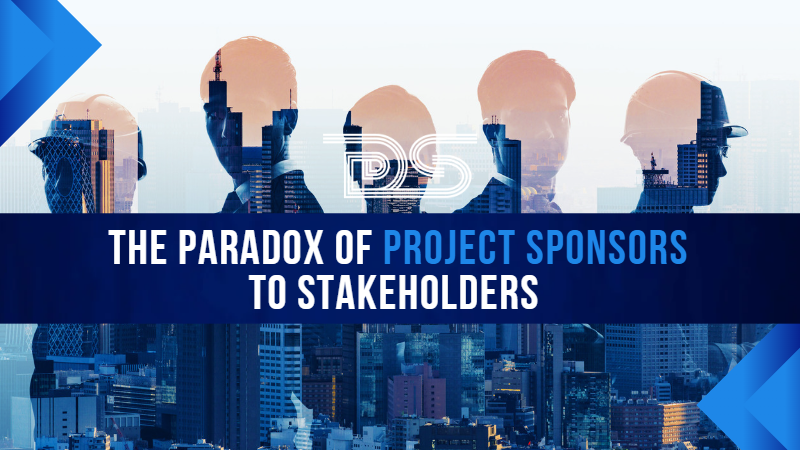
by DharamCW | Mar 10, 2023 | General
A project is deemed successful when it meets or exceeds the expectations of its stakeholders. Every project has a unique set of stakeholders—sometimes far too many. Trying to meet all of their requirements is more often an impossible task. Nonetheless, the project manager must deal with all stakeholder situations smoothly because the stakeholders and the people they represent often evaluate the project’s success.

Project Stakeholders
But who are the stakeholders? According to PMI, “Project stakeholders are individuals and organizations who are actively involved in the project, or whose interests may be positively or negatively affected as a result of project execution or successful project completion.”
Stakeholders can be internal or external to the organization that is carrying out the project.
“Project Sponsor” is also a stakeholder, typically an organization executive with authority to assign resources and enforce project decisions. Project sponsors are called internal stakeholders in the project. Stakeholders include the project manager, project team members, and managers from other departments within the organization. Identifying all project stakeholders as early as possible in a project is critical. Leaving out key stakeholders or the department’s function and not discovering the fault until the project is well underway could be disastrous.
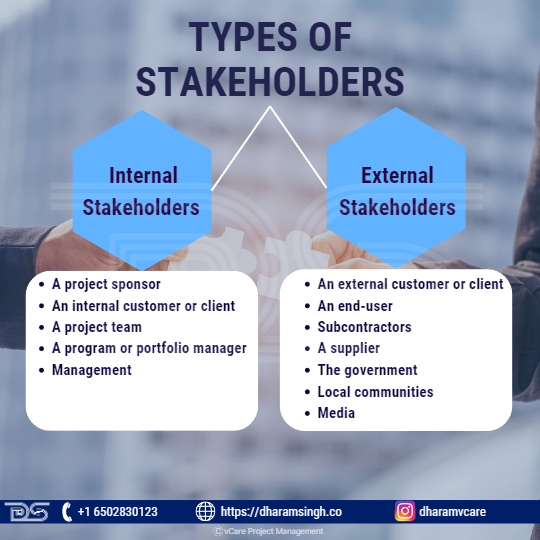
Types of Stakeholders
Types of Stakeholders
There are two types of project stakeholders:
- Internal Stakeholders
- External Stakeholders
Internal stakeholders are individuals or businesses whose relationship with a company is determined by their position within its structure. As the name implies, these individuals are involved in a project from the inside. They are as follows:
- A project sponsor
- An internal customer or client
- A project team
- A program or portfolio manager
- Management
- Another team’s manager of the company
External stakeholders are those interested in a company’s operations. Still, they do not necessarily have a role in the decisions of the business. However, they can influence success or failure based on their vested interests. They can be just as powerful as internal stakeholders. These stakeholders are not directly involved in the project but are affected by its outcome.
- An external customer or client
- An end-user
- Subcontractors
- A supplier
- The government
- Local communities
- Media
Characteristics of Stakeholders in a Project
- When contributing to a project, stakeholders have varying levels of responsibility and authority. This level may change as the project progresses. It can range from one-time contributions to complete project sponsorship.
- Some stakeholders may also actively or passively undermine the project’s success. These stakeholders require the project manager’s attention throughout the project’s life cycle.
- Stakeholder identification is a continuous process throughout the project’s life cycle. Identifying them, understanding their level of impact on a project, and meeting their demands, needs, and expectations are critical to the project’s success.
- Just as they can positively or negatively impact a project’s objectives, stakeholders can perceive a project to have positive or negative outcomes.
- A project manager’s most important role is managing stakeholder expectations, which can be challenging because stakeholders often have different or conflicting goals.
Stakeholder Management
Stakeholder management is the process of organizing, monitoring, and improving relationships with stakeholders. It entails systematically identifying stakeholders, analyzing their needs and expectations, and planning and carrying out various tasks to engage them. In addition, a good stakeholder management process will allow them to coordinate their interactions and evaluate the status and quality of their relationships with various stakeholders.
A critical component of running a successful project is developing and maintaining positive relationships with the affected communities and other stakeholders.
Investing time in identifying and prioritizing stakeholders, as well as assessing their interests, provides a solid foundation on which to build the stakeholder engagement strategy. In addition, good stakeholder management includes ‘business intelligence.
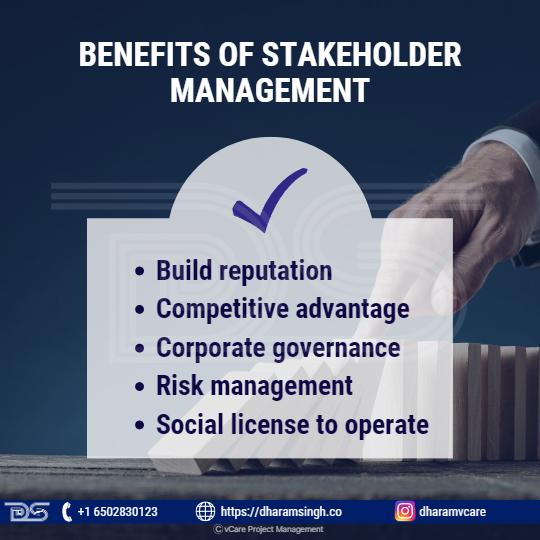
Benefits of Stakeholder Management
Benefits of Stakeholder Management
- Build Reputation
- Competitive advantage
- Corporate governance
- Risk management
- Social license to operate
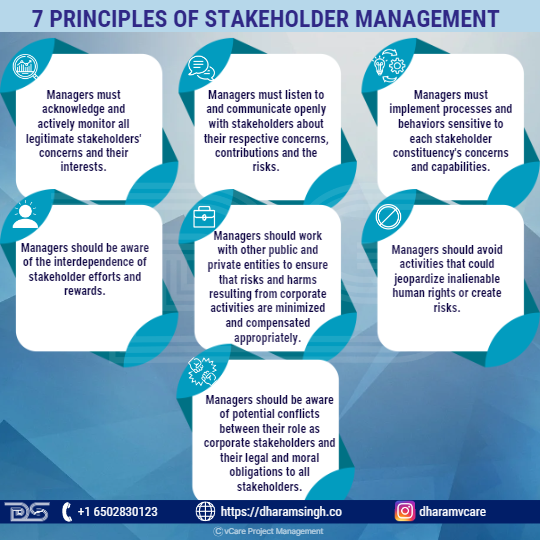
7 Principles of Stakeholder Management
7 Principles of Stakeholder Management
Clarkson Centre created the seven principles of Stakeholder Management for Business Ethics under the leadership of Max Clarkson. The Clarkson Principles are, in many ways, “meta-principles” that encourage management to embrace specific stakeholder principles and implement them according to the norms.
- Managers must acknowledge and actively monitor all legitimate stakeholders’ concerns and consider their interests in decision-making and operations.
- Managers must listen to and communicate openly with stakeholders about their respective concerns and contributions and the risks they face from their involvement with the corporation.
- Managers must implement processes and behaviors sensitive to each stakeholder constituency’s concerns and capabilities.
- Managers should be aware of the interdependence of stakeholder efforts and rewards and make an effort to fairly distribute the costs and benefits of corporate activity among them while taking into account their risks and vulnerabilities.
- Managers should work with other public and private entities to ensure that risks and harms resulting from corporate activities are minimized and compensated appropriately where they cannot be avoided.
- Managers should avoid activities that could jeopardize inalienable human rights or create risks that, if clearly understood, would be patently unacceptable to relevant stakeholders.
- Managers should be aware of potential conflicts between their role as corporate stakeholders and their legal and moral obligations to all stakeholders and address such conflicts through open communication, appropriate reporting and incentive systems, and, if necessary, third-party review.
Understanding the Stakeholders
A good understanding of the stakeholders is the key to successful stakeholder engagement. In addition, understanding stakeholder concerns and interests can lead to product or service ideas that address stakeholder needs while allowing the company to cut costs and maximize value.
1. What else can you learn about stakeholders to better understand their needs, priorities, preferences, and concerns? Consider:
- Demographic data- Ensure to engage with a diverse community and stakeholder groups.
- Social networks- Focus on the important, often undocumented, social connections between stakeholders.
2. Stakeholder Mapping – Stakeholder mapping is the visual process of depicting all stakeholders of a product, project, or idea on a single map. The main advantage of a stakeholder map is that it provides a visual representation of all the people who can have an impact on your project and how they are connected.
3. Salience model – investigate the power, urgency (need for immediate action), and legitimacy (appropriate stakeholders), as well as the interaction or groups of stakeholders that result.
4. Determine stakeholder expectations and compare them to the scope and expectations of the project or organization for which the engagement program is being run. Is there a mismatch in expectations, and how will this be addressed? Consider the following:
- What information do they need from you, how often, and in what format/channel do they want it?
- What is their financial/social/emotional stake in the outcome of the work? Is it favorable or unfavorable?
- What primary motivations will shape their perceptions of your project or organization and their interactions with you?
- What are their current feelings about the organization and project? Is it founded on reliable data?
- Who influences their thoughts, and who are they influenced by?
Ways to deal with common stakeholder problems and challenges
- Stakeholder conflict occurs when different stakeholders have incompatible goals. It causes a “problem” for the company because it can impact its performance and success.
- Conflict necessitates that businesses effectively manage stakeholder interests. Not all stakeholders are strategically important to the company. As a result, businesses must determine which ones should be prioritized.
- Potential problems can be avoided by conducting an upfront analysis of who the stakeholders are and how and when to involve them in the project.

Analysis of common stakeholder issues
Analysis of common stakeholder issues
As no two stakeholders are the same, the issues they may introduce into a project will be vastly different. This factor means there could be many reasons why a project encounters stakeholder resistance or the project team struggles to gain traction. Identifying stakeholder issues during the project can help with planning ahead of time and preparing an appropriate response.
- Trying to align different stakeholders.
It is generally a good thing to have a variety of interests in the project and its outcome, but having a lot of different stakeholders can also pull the project team in too many different directions. In addition, it can be challenging for project managers to coordinate too many different stakeholders, which could add new difficulties to the project.
- Competing priorities between stakeholders
Stakeholders bring their objectives and expectations to the project. However, at least a few of these priorities frequently conflict with or compete with one another. In addition, priorities may vary depending on the department, the role, or the professional backgrounds of the individuals.
- Resource constraints
It’s possible that the team lacks some of the resources they require or that the project is utilizing resources that other stakeholders consider crucial to their projects. Resource competition is common in organizations and can lead to conflict.
- Breakdowns in communication
Effective communication between stakeholders and the project team is crucial for everyone to achieve their objectives and for the project to be successful. When there are communication breakdowns, the project may be delayed, or the team may not receive the necessary information. Without deliberate communication, stakeholders might unintentionally hinder the project’s success.
- Stakeholders are resistant to sharing information.
At times, important project sponsors are more focused on their success and fail to promptly or completely provide the stakeholders with the required information. As a result, stakeholders may attempt to disrupt a project unintentionally or on purpose.
- Potential implications of conflict with a sponsor
Conflict with project sponsors may have many consequences on the project management, such as these typical ones:
- The project’s progress is being slowed
- Reducing the effectiveness and timeliness of decision-making
- Putting team cohesion in jeopardy
- Undermining a project manager’s authority
- Fostering hostility and encouraging uncooperative behavior
- Creating a fearful environment for other stakeholders
- Obscuring the project’s vision
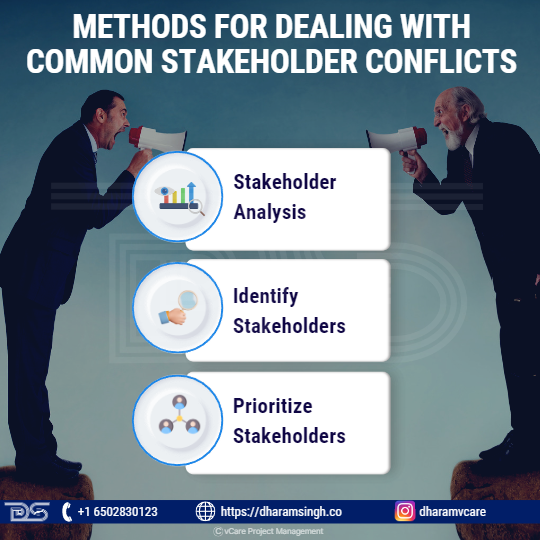
Methods for dealing with common stakeholder conflicts
Methods for dealing with common stakeholder conflicts
- Stakeholder analysis
Stakeholder analysis can offer insightful information and guidance, just as project managers must carefully examine resources and specifics. It can be helpful to respond appropriately by taking the time to consider how stakeholders affect the project’s progress.
By conducting a stakeholder analysis, one can learn how to control expectations, channel stakeholder influence toward project objectives, and deliver the information and updates that stakeholders expect from their team.
- Identify stakeholders
One must first identify the stakeholders to analyze them effectively. List every stakeholder that comes to mind, then include more individuals and organizations as necessary. As stakeholders, all parties involved in the project, those with authority over it or an interest in its success, should be listed.
- Prioritize stakeholders
The list of stakeholders can then be ranked according to impact, interest, and power. For instance:
- Key stakeholders: This first group heavily influences and controls the project. This group is frequently accurate for executive leadership at the company.
- Primary stakeholders: The project immediately affects the key stakeholders. This pack may include team members, departments, and internal or external clients who stand to gain from the project’s outcomes.
- Secondary stakeholders: The secondary stakeholders are those who play a supporting role, are indirectly impacted or have a less significant stake in the project.
Understand the key stakeholders
A few stakeholders are usually critical to the project. Key stakeholders invoke more power and may have a more significant stake in the project’s success than primary or secondary stakeholders. For example, key stakeholders could include their boss, company executives, or team leaders.
Finding the key stakeholders and understanding what they need can help keep the project on track because they may control important resources, have a significant impact on the project, or grant the necessary approval.
Create a communication plan
With a communication plan, project leaders will be better prepared to manage their stakeholders on the fly and keep the project moving forward.
- Create your communication strategy based on what the project leader knows about their stakeholders.
- Keeping track of what the stakeholders require from themselves allows project leaders to stay organized and focused on managing the project.
- Gaining the stakeholders’ trust is essential once the developed strategy has been implemented. Rather than dictating the project to them, make each stakeholder a priority – as appropriate – and give them space to contribute.
Final Thoughts
Different stakeholders in the project have different expectations. Project managers should look for potentially hazardous situations when those expectations might clash. Then, they must address and resolve the conflict or risk endangering the project and themselves.
Resolving stakeholder expectations conflicts is always linked to project success. Furthermore, using various forms of communication among the project team, such as senior management and stakeholders, increases the likelihood of mutual understanding. These techniques help project managers align stakeholder expectations and reduce the possibility of project distress.
Feel free to check out my discussion on this topic with Thomas Walenta in YouTube
For any questions related to your Project Management career, training, and certifications, you can book an obligation free 15 minutes session with me by visiting http://talktodharam.com/
You can subscribe to the vCare Project Management YouTube Channel to catch future videos of our Q&A series and certification success stories: https://bit.ly/2YF0wJl
You can subscribe to and follow my podcasts and interviews with Project Management Experts on YouTube at https://bit.ly/2NDY8wd
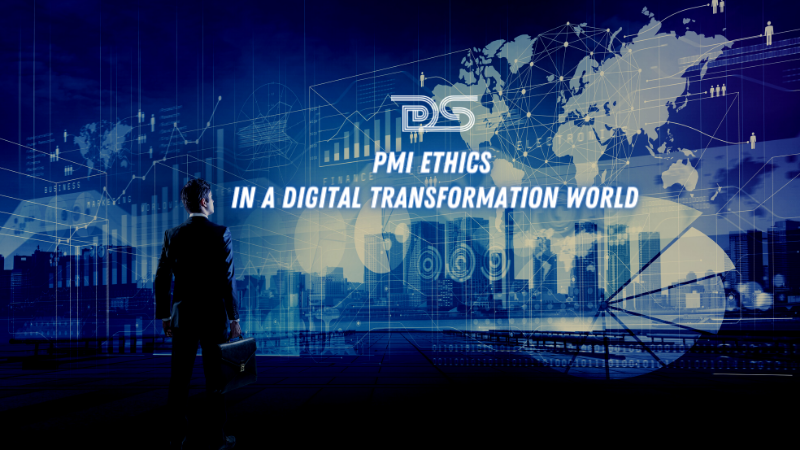
by DharamCW | Apr 20, 2021 | General
According to the PMI (Project Management Institute), “Ethics is about making the best possible decisions concerning people, resources and the environment. Ethical choices diminish risk, advance positive results, increase trust, determine long term success, and build reputations. Leadership is dependent on ethical choices”. Ethics represent a crucial differentiator in a highly competitive market where reputation and values are highly appreciated among the Project Management Professionals.
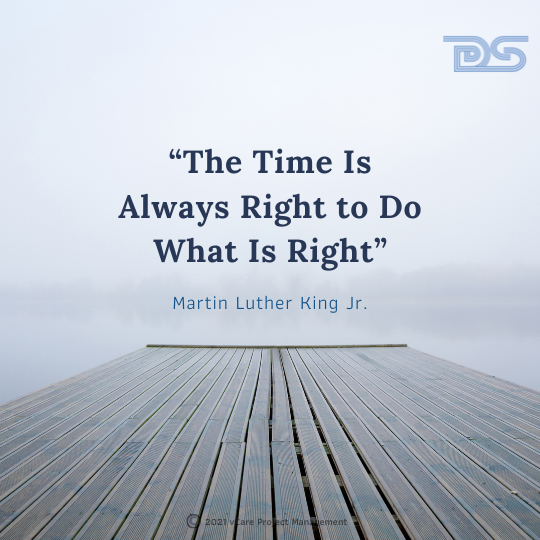
The Time Is Always Right to Do What Is Right
Martin Luther King Jr. said, “The Time Is Always Right to Do What Is Right”. As project managers/program managers or portfolio managers, we must make critical decisions daily. Though in the evolving digital transformation world, many decisions might go unnoticed, few do get noticed, as critical ones. These decisions have a profound impact on people, resources, and the environment. Some decisions might have led to conflicts, dilemma, or the creation of new risks.
What is Ethics, and what is the Role of PMI?
Ethics is the branch of knowledge that deals with moral principles. It involves steps, including systematizing, defending, and recommending concepts of right and wrong behaviours.
Regarding ethics at PMI, in the year 1981, the PMI team formed the PMI Board of Directors on Ethics, Standards, and Accreditation. The current PMI ethics document outlines the essentials of ethics based on Vision, Responsibility, Respect, Fairness, and Honesty. PMI expects its members to adhere to these codes of ethics to uphold its values.
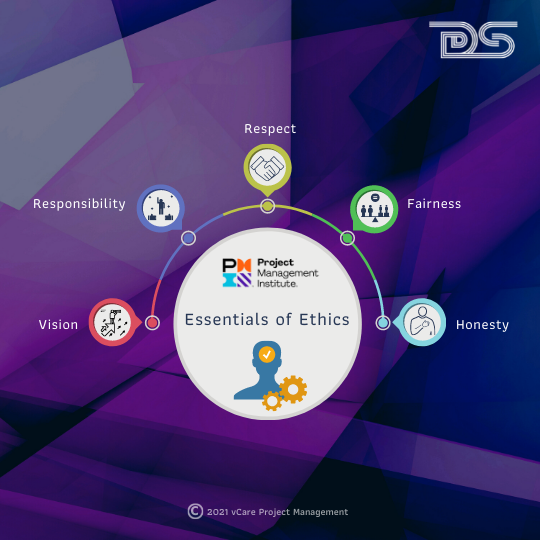
Essentials of Ethics
When the whole world is fighting the COVID-19 situation, and demand for digital transformation projects is at an all-time high, PMI professionals need not ask for a better time to establish high ethical standards. Let’s understand the key challenges a PMI trained professional faces in the current digital transformation world.
Digital Transformation
Digital transformation is the process of using digital technologies to create new — or modify existing — business processes, culture, and customer experiences to meet changing business and market requirements.
There are four types of digital transformation: business process, business model, domain, and cultural/organizational. We often see corporations focused solely on the process or organizational transformation.

Digital Transformation
There are three essential components of a digital transformation:
- The overhaul of processes
- The overhaul of operations, and,
- The overhaul of relationships with customers.
The crucial elements that every digital transformation program needs to focus on are,
- Customer focus
- Organisational structure
- Change management
- Transformational leadership
- Technology decisions involve the whole c-suite
- Integration of data
- Internal customer experience
- Logistics and supply chain
- Data, security, and privacy
- Evolution of products, sales, and process around the delivery
- Digitisation
- Personalisation
The key aspects of the digital transformation world could have a major impact on Ethics.

Major impact on Ethics
The transformative effect of Process with Digital Technology: Award-winning Author James Moor in 1985 mentions the transformative effect Digital Transformation could create. He cites the example transformation of manual votes to Electronic Voting Machines, which might benefit from speed and accuracy. On the contrary, it could impact security, vulnerability, transparency, and trustworthiness related issues.
Projects executed in Virtual environments: Today, the projects get implemented in remote places – Home/Office/Small Office combinations. People are working from remote, and it has become the new normal. People significantly use collaboration tools and in some occasions even communicate using social media, which could be manipulative.
Blogging/Newsletters/Social Media Platforms: Professionals tend to share the experience and insights reflecting upon the work ecosystem. Either sharing happens as an experience in a newsletter or a blog post, or it could be even a Twitter thread or a simple tweet reflecting a view. This act is typically done by those who tend to be expressive even within a professional organizational setup.
Global and fast-moving digital society: Communications spread very fast, and a diverse global culture leaves very little control. Digital technology, which is supposed to help leverage, could turn dangerous. The expectation for responsiveness sometimes leaves very little room for interpretation.
Real-world pressures or Peer Competition: Today’s real-world information sharing creates unwarranted peer pressure. This pressure might develop dilemmas and force individuals towards adverse decision-making. Sometimes, due to competitive peer pressures or financial pressures, even the employees’ health and safety concerns might get overseen.
Confidentiality and data security issues: Enhanced digital transformations across the globe have made data exchange easier. In the case of a data expose, it is vital to understand what is exchanged and what is the importance of the exchanged data. Lack of understanding of the data classification at appropriate levels could become risky when the proper accountability level could not be ascertained.
Disruptive AI Tech: Disruptive AI tech such as Chatbots, Speech Recognition Systems, etc., has made the way we think of data and decision making. Too much dependence or flawed inference might have an impact.
Ethics focus on PMIs Performance Domains & Digital Transformation
When a portfolio/program/project vision is established and defined, observable outcomes between the current state and future state as part of the digital transformation must be counted in. The key components that would impact the above said performance domains would be done with re-imagination, cultural change, and cross-functionality.
Digital transformation might have changed in a newer business model, new product focus, and a more contemporary way of working. Digital transformation is about getting the technology right and building necessary support and buy-in from the people managing resistance. Business processes need to be horizontally redesigned to enable collaboration across the teams.
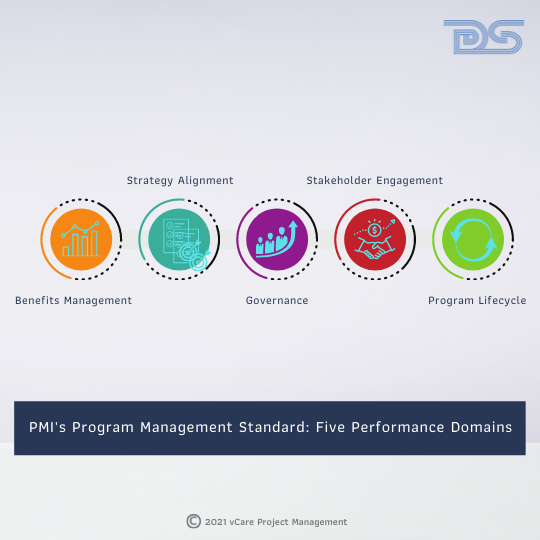
PMI’s Program Management Standard
PMI’s Program Management Standard defines five performance domains that can be integrated with ethics, giving a significant shift in ethics adoption, and may help in improving overall digital transformation initiatives. They are:
- Benefits Management: Benefits profile, which would be based on outcomes and measurement, has to have the ingredients of the ethics as well.
- Strategy Alignment: Strategic alignment to focus on the changing business environment and strategic targets on digital transformation must be governed through ethics.
- Governance: Governance focus and establishes control related to programs. Governance would bring discipline and ethics into the broader organizational structure.
- Stakeholder Engagement: Stakeholders to be kept well informed on the ethical aspects of getting involved whenever any changes in stakeholders.
- Program Lifecycle: Given a structure and suggested flow for a program, the ethics principle has to be adopted to address dilemmas related to circumstances of a business and initiative.
5As Decision-Making framework
PMI has recommended the 5A’ss decision-making framework outlines with Assessment-Alternatives-Analysis-Application-Action. The 5A’s assessment helps to collate all the facts about the ethical dilemma. It considers all your choices. Subsequently, decision candidates are identified and tested for their validity. Apply these principles to the candidates and make the final decision.

5As Decision-Making framework
The decision-makers, when they adopt the 5A decision-making framework, the following checklist:
Assessment
- Does it adhere to the law?
- Does it comply with PMI code of ethics ?
- Does it comply with the organization code of ethics?
- Does it comply with the professional conduct ?
- Does it comply with the ethical values and culture of ecosystem?
Alternatives
- Whether alternatives are listed ?
- For the given choices do we have pros and cons ?
Analysis
- What kind of impact it would make ? (Positive/Negative)
- Does it count in cultural differences ?
- Is this decision taken considering long term impact ?
- Is this decision taken without any external influence ?
- Were you calm and unstressed during this decision ?
Application
- Will the decision be for larger good ?
- Has the decision is without any bias ?
- Is this fair for all concerned ?
Action
- Will you take responsibility ?
- Would you be ok to make your decision public ?
- Are you ready to act ?
Benefits:
When the portfolio managers and program managers adopt the above-said approach outlined in the PMI code of ethics, it provides the following benefits:
- Elevates the profession and raises future standards
- Increases the faith and trust among peers
- Imprints on individual moral mindsets and behaviors
- Improves business relationships across the board
- Promotes fair decision making
- Reduces project risks
- Reduces anxiety and stress and ultimately turnover in projects
Conclusion
Transparency and integrity must be the core values which has to be established by the professionals. The data must be used in responsible and ethical ways during the digital transformation initiative. Data collection has to be based on the ethics principle called “Informed Consent.” The actions cannot be intrusive, manipulative, or disrespectful to others.
Trust must be established among the individuals, groups, or organizations involved in the digital transformations. This trust can be created by establishing data provenance, traceability from the source to the user interface. Program managers or portfolio managers have to act without any bias and with a high level of integrity and impartiality. The same has to be established for the clients, suppliers, and subcontractors without any favoritism and giving them an unfair advantage.



































Recent Comments